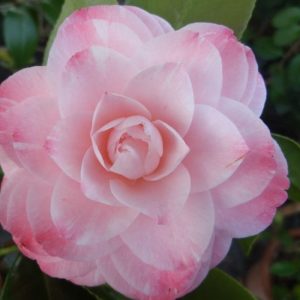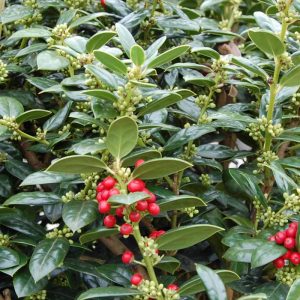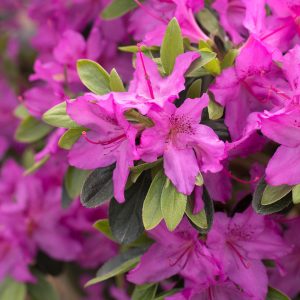December Gardening Tips
Speaking of Christmas trees, check out some possible options for a Living Christmas Tree!
Living Christmas Trees
Would you like to enjoy a beautiful Christmas tree that you then can plant and enjoy for years to come? Stop by the Garden Center to see some. Here are some good choices:
Here are some good choices:
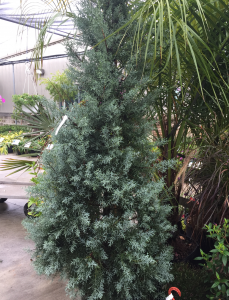
Carolina Sapphire Cypress
Carolina Sapphire Cypress is a great option. It is a silvery green color and has the “Christmas tree” shape that is desirable. Plant the tree in the ground in a bright sunny area that has the room to allow it to grow. The height will be about 30 feet with a spread of about 15 feet.
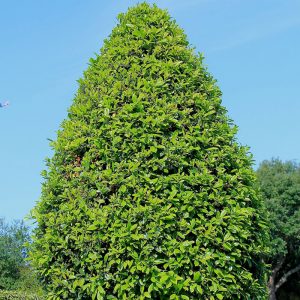
East Palatka Holly
Hollies are another good choice. East Palatka Hollies are a common variety in this area. They also have the “Christmas tree” shape when they are smaller. Hollies have bright red berries that add to the festive look. These trees can be planted outside as well in a bright sunny area. They also would be about 30 feet tall with a spread of 15 feet.
Southern Red Cedar is a Florida native tree that is a beautiful evergreen. The dense growth and attractive foliage makes Southern Red Cedar a favorite for windbreaks, screens and wildlife cover. It is highly salt tolerant and a moderately fast grower. It thrives in hot sun or part shade and can grow upward to 30 feet high and about 15 feet wide. Small black berries appear later in the year.
Eleocarpus- Japanese Blueberry is another great option! It is trimmed in the “Christmas tree” shape frequently and can be planted outside after Christmas. It can be kept clipped in its current shape and size or allowed to grow bigger. It produces a berry in the fall that is blue that the birds enjoy.
Arborvitae is another great evergreen small tree that also provides windbreaks, screening and wonderful cover for birds. It grows somewhat pyramidal and has a dense foliage. It performs well in full sun to partial shade. It is a moderately fast grower and tolerates drought well, once established. Depending on the variety- growth ranges from about 7-10 feet tall and 6-8 feet wide.
Winter Color
December is the perfect time of year to plan for some winter color! Our “snowbird” friends, in particular want to have lots of color while they enjoy the Florida sunshine.
Winter annuals such as alyssum, dianthus, dusty miller, pansies, petunias, snapdragons, violas and geraniums all thrive in the cooler temperatures! Geraniums will need protection from freezing but the others can tolerate light freezes.
Seasonal plants that reflect the season also provide splashes of color. Beautiful poinsettias to name one. Christmas cactus will start showing color soon as well kalanchoe. These plants, along with last year’s poinsettias all have a special need- no nighttime light during the fall- including porch lights. Once your plants start to show color they can come back into the lights.
As our landscapes start to go dormant this time of year- camellias provide such a bright burst of color in our otherwise colorless gardens. Camellias are dark green, evergreen, cold hardy shrubs that perform beautifully here. They do best in dappled sun or shifting shade- protected from the harsh middle of the day sun. They are acid loving plants- under pines or oak trees are an idea location.
There are two major groups of camellias: camellia sasquana and camellia japonica. The sasanquas generally are blooming now with smaller, simpler flowers. Camellia japonicas, on the other hand, have large showy flowers and bloom typically from January to March.
There are many varieties of each available now at the Garden Center.
This time of year hollies put on a spectacular show with trees laden with bright red berries! Yaupon hollies, Eagleston, East Palatka, Nellie Stevens and Dahoon Hollies all do well in our area. Plan ahead for the “holiday” show these trees put on.
Plan on adding some azaleas now to your garden for a beautiful flower show in February and March. Larger growing Formosa azaleas that range in color from lavender, light pink, red or white, produce big bold flowers that are extremely showy and flower for about 6 weeks.
Semi-dwarf varieties that do best for our area are Red Ruffles and Fashion, Prize. These semi-dwarf azaleas grow about 3’-4’ and bloom sporadically during the year and then bloom profusely in February with other azaleas.
Azaleas, like camellias, prefer acid soil with afternoon shade or dappled/shifting sunlight.
